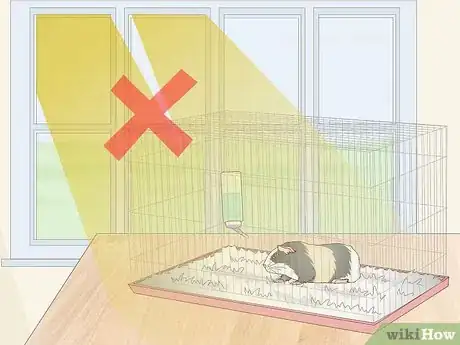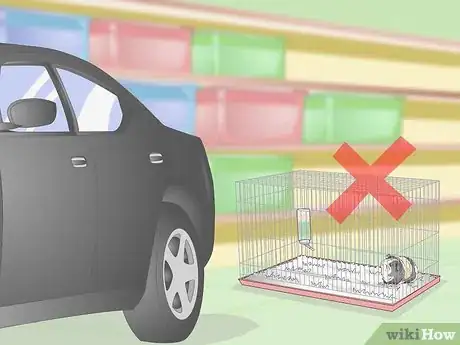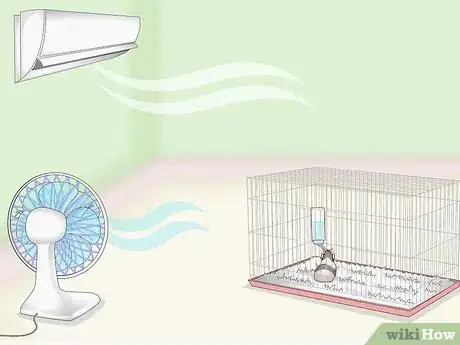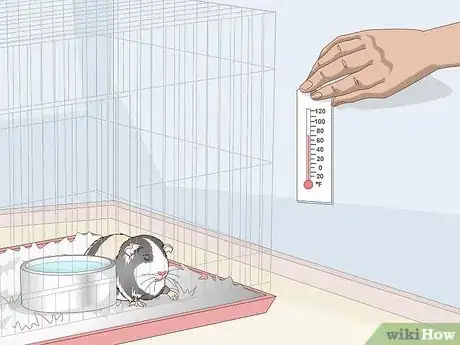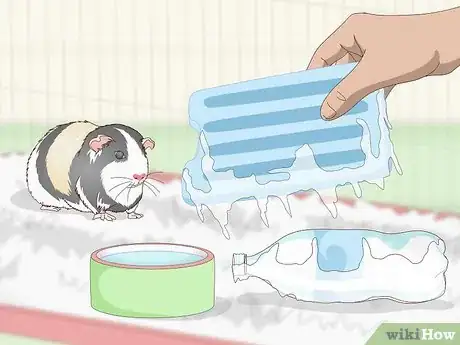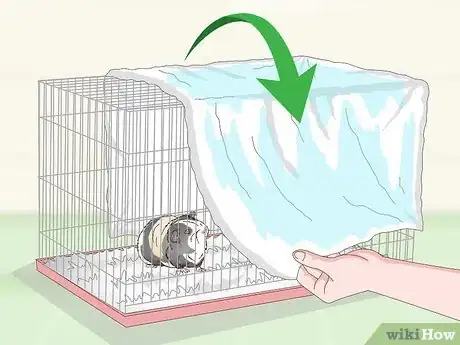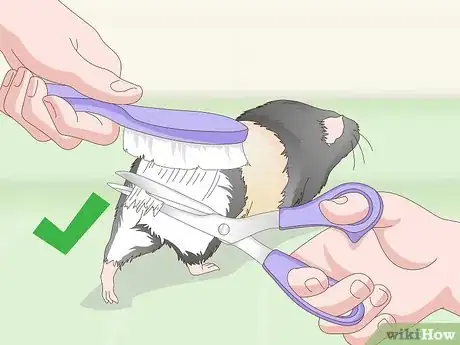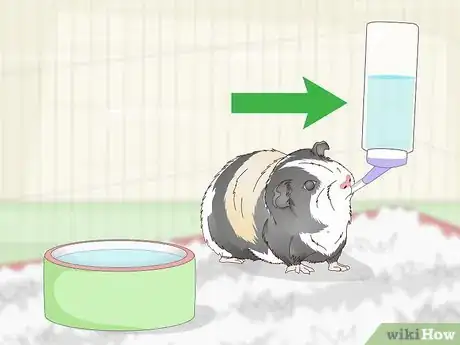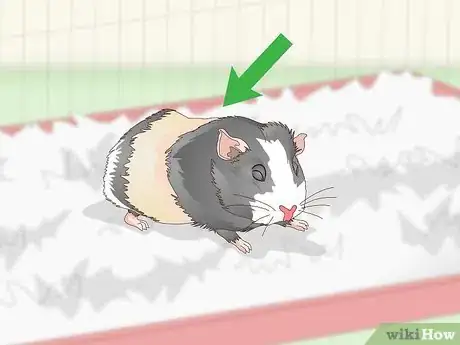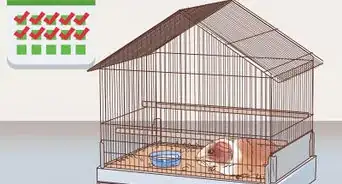This article was co-authored by Pippa Elliott, MRCVS. Dr. Elliott, BVMS, MRCVS is a veterinarian with over 30 years of experience in veterinary surgery and companion animal practice. She graduated from the University of Glasgow in 1987 with a degree in veterinary medicine and surgery. She has worked at the same animal clinic in her hometown for over 20 years.
wikiHow marks an article as reader-approved once it receives enough positive feedback. In this case, 95% of readers who voted found the article helpful, earning it our reader-approved status.
This article has been viewed 89,262 times.
Guinea pigs aren’t used to being out in the heat and are thus especially prone to suffering from heat stress. This means that during the hot summer months, it’s very important that you take extra care in keeping your guinea pig cool and keeping its cage below 86 °F (30 °C). Luckily, by controlling the environment that your guinea pig is kept in and by keeping your guinea pig groomed and hydrated, you can help keep your pet much cooler in the summer.
Steps
Controlling Your Guinea Pig’s Environment
-
1Move your guinea pig indoors if you normally keep it outside. The most effective way to keep your guinea pig safe from the heat is to move it from outdoors to indoors (if it isn’t already inside). The lower temperature inside your home will certainly help it stay cool, especially if you have fans or air conditioning.[1]
- Wherever you put your guinea pig, make sure it’s safe from any other pets or young children you have in your home.
- If you choose to place your guinea pig in the laundry room, refrain from running the washer or dryer while it’s in there. Guinea pigs are sensitive to loud noises and the machines will also give off a good bit of heat.
- If moving your guinea pig indoors isn’t an option, make sure the run is located in a shady spot and out of full sunlight.
-
2Avoid putting your guinea pig’s cage in any direct sunlight. Being exposed to direct sunlight can cause the cage to rapidly heat to an uncomfortable temperature. Keep the cage in a shaded area of your home away from windows or under a small parasol. If you can’t bring the cage indoors, at least put it under a shady tree or under the roofing of your house.[2]
- Note that if wherever you put your guinea pig’s cage makes your guinea pig less visible to the naked eye, you’ll need to check on it more often just to make sure it’s ok.
- You can minimize the amount of sun that seeps through your windows by covering them with room-darkening curtains.
Advertisement -
3Refrain from keeping your guinea pig in a shed or garage. The heat can be twice as bad in poorly ventilated places like these, especially as the humidity level rises. Wherever you choose to keep your guinea pig’s cage, make sure the location is well ventilated and has a good flow of air.[3]
- Housing your guinea pig in a shed or garage can lead to death, so please take caution!
-
4Use fans and air conditioning to keep the cage cool. If you’re using a fan, point it away from the guinea pig instead of directly onto it. Fans can help cool the air, but the feeling of having air constantly blown at it can stress out your guinea pig.[4]
- Make sure the air in the cage doesn’t get too cold as a result of using air conditioning. Your guinea pig’s cage should never be colder than 50 °F (10 °C).
-
5Use a thermometer next to the cage to monitor its temperature. Place a stand-alone or wall-mounted thermometer immediately adjacent to the cage to get the best reading of the cage’s internal temperature. Make sure this temperature stays between 65 and 75 °F (18 and 24 °C).[5]
- This is the ideal temperature range for guinea pigs.
-
6Place ice packs or frozen water bottles in the cage. Your guinea pig will enjoy lying down next to these items to cool off whenever it gets too warm. Plus, they help to insulate cold air in the cage. Gel cushions and cool tiles can also be used instead of ice packs or frozen water bottles.[6]
- Plastic water bottles can be filled with water and then frozen overnight. Wrap them in old tea towels or flannels and place them into the cage.
- Old tiles can be placed in the freezer to cool overnight and then put inside the cage for your guinea pig to rest on or near.
- Chilled gel packs can also be used as long as your guinea pigs won't chew them!
-
7Consider partially covering the cage with damp cloths and towels. The dampness can help insulate cool air in the cage as well as reduce heat stress. Rinse the cloth in ice-cold water and make sure you drain it off afterward. Make sure you only cover part of the cage to ensure that you can see the guinea pigs and they can see you.[7]
- Avoid placing the cloth over the food bowl, as this can end up spoiling the food pellets in the bowl.
Keeping Your Guinea Pig Groomed and Hydrated
-
1Trim your guinea pig’s coat and keep it groomed if it has long hair. Long-haired breeds can easily suffer from heatstroke due to the added insulation from their long coat. If your guinea pig has long hair, monitor it closely and consider trimming its coat. This will significantly lessen the amount of heat stress on it.[8]
- Use a small brush to brush out any excess fur that accumulates in your guinea pig’s coat.
- If your guinea pig is comfortable with it, you can also dampen its fur with a tepid cloth to help it cool off.
- Take care not to trim your guinea pig’s coat down to the skin. If you’re using electric clippers, you can add an attachment to control the length of the clip.
-
2Refill your guinea pig’s water daily to ensure it has a constant supply. Water can evaporate or even heat up in hot weather, which is a problem because guinea pigs sometimes refuse to drink warm water! Top off the water in the cage at least once each day, and 3 times on a hot day, and feel the water to make sure it stays at room temperature.[9]
- Consider keeping a second water spout in the refrigerator and replacing the main spout with this secondary one whenever it gets too hot.
-
3Provide more than 1 water source if you have more than 1 guinea pig. Not only is the extra water more important during warm weather for keeping your guinea pig hydrated, but if you have 2 or more territorial guinea pigs, they may not want to share the water. Thus, providing more than 1 water spout or water bowl will better ensure your guinea pigs are staying adequately hydrated.[10]
- Aim to have 1 water source per guinea pig in your cage.
-
4Feed your guinea pig water-heavy foods to help keep it hydrated. Opt for foods that have a higher water content, such as cucumbers and berries, which will help to ease discomfort in high heat. You can also soak your guinea pig’s leafy greens in ice water before feeding it to give it extra water in its food.[11]
- Don’t overdo it, though; feeding your guinea pig too many water-heavy foods can lead to stomach problems.
- You can also try feeding your guinea pig frozen vegetables if it likes them.
-
5Watch out for signs of heatstroke in your guinea pig. If your guinea pig isn’t adequately cooled or hydrated, it may suffer heatstroke, which can be a serious medical problem. The symptoms of heatstroke in guinea pigs include lethargy, restlessness, panting, salivating, and convulsions.[12]
- If your guinea pigs suffers a heatstroke, dampen its fur with cool water and seek medical attention immediately.
- Check on your guinea pig frequently when the weather is hot so you can catch any signs of heatstroke right away.
Warnings
- Avoid plastic cages, roofing, and huts, since plastic heats up relatively quickly.⧼thumbs_response⧽
Things You’ll Need
Controlling Your Guinea Pig’s Environment
- Non-plastic cage
- Fan or air conditioning unit
- Thermometer
- Ice packs or frozen water bottles
- Damp cloths or towels
Keeping Your Guinea Pig Groomed and Hydrated
- Small brush
- Extra water spout or bowl
- Water-heavy foods
References
- ↑ https://www.bluecross.org.uk/pet-advice/how-keep-guinea-pigs-cool-heat
- ↑ https://www.pdsa.org.uk/taking-care-of-your-pet/looking-after-your-pet/rabbits/beat-the-heat-keeping-rabbits-and-guinea-pigs-cool-in-summer
- ↑ https://www.animalbliss.com/tips-to-keep-your-guinea-pig-cool/
- ↑ http://www.onlineguineapigcare.com/20-ways-to-keep-a-guinea-pig-cool-in-hot-weather/
- ↑ https://www.humanesociety.org/resources/guinea-pig-housing
- ↑ https://www.bluecross.org.uk/pet-advice/how-keep-guinea-pigs-cool-heat
- ↑ http://www.onlineguineapigcare.com/20-ways-to-keep-a-guinea-pig-cool-in-hot-weather/
- ↑ http://www.onlineguineapigcare.com/20-ways-to-keep-a-guinea-pig-cool-in-hot-weather/
- ↑ http://www.onlineguineapigcare.com/20-ways-to-keep-a-guinea-pig-cool-in-hot-weather/
About This Article
To keep your guinea pig cool in hot weather, keep its cage indoors and out of direct sunlight. You can also place ice packs or frozen water bottles in your guinea pig's cage so it can curl up next to them when it's too warm. Also, try draping a damp, cold towel or cloth over part of your guinea pig's cage to insulate the cool air in the cage. You should also make sure your guinea pig has access to fresh water at all times so it doesn't get dehydrated. For more tips from our Veterinary co-author, like how to use fans and air conditioning to keep your guinea pig cool, read on!

